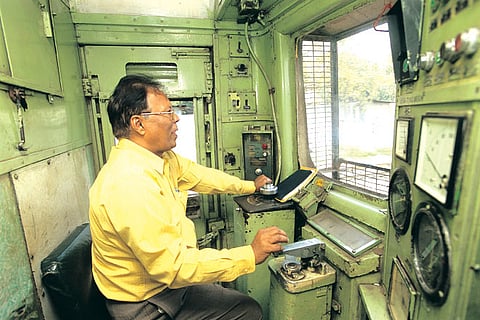
- Destinations
- Experiences
- Stay
- What's new
- Editor’s Picks
- Responsible Tourism
- CampaignsCampaigns
- Subscribe

In the 4x12-ft cab of the 1136 to Virar, motorman Rakesh Saxena has a battleworthy array of cranks, levers, gears, gauges, wheels, alarms and switches within arm&rsquos reach. The gizmos tell the 59-year-old veteran driver whether all passengers have boarded or not, whether the rail ahead is fractured, or whether a level crossing may be open about any obstacle on the lines, an electric supply glitch in any motor coach, and the status of a signal he has sent to the command center. But none of these devices is quite as indispensable as the two &lsquohooter valves&rsquo&mdashmetal pedals&mdashat his feet.
Now, as the Fast Local slices at 68km per hour out of Churchgate, Saxena spots a man with a blue satchel ambling across the tracks. He lightly stamps on the hooter valve a sonorous blast sounds the man scurries. When the train overtakes him, he is barely a couple feet away from the lines. &ldquoThe most important thing we look for is the signals,&rdquo Saxena says, then amends, &ldquoAnd equally important are the trespassers&hellip Even for the dogs, we apply the hooter and apply brakes.&rdquo
After 38 years on Mumbai&rsquos Western suburban line, the amiable motorman is unfazed by the legions of foolhardy that unfailingly jump tracks as the train slows while approaching the 14 stops between Churchgate and Virar. At Mumbai Central, they include a gaggle of schoolboys walking three abreast with interlinked arms. At Dadar, a man with a child asleep on his shoulder. At Bandra, women with baskets on their heads. Trespass they will, even if that means darting under closed level crossings, ignoring the overbridges, or breaking stone walls. Dutifully, in each instance, Saxena sounds the hooters.
The Western suburban line averages five fatalities daily. Saxena says that after his first &lsquoknock-down case&rsquo, he couldn&rsquot eat. Now he is more matter of fact. &ldquoWhat I will do I will cry, &lsquoKya meri gaadi se hi marna tha&rsquo&rdquo
As the train comes to a halt at Andheri, Saxena takes his hand off the master controller key&mdasha metal crank topped with a white knob&mdashand folds his arms across his chest. This, he explains, is an additional safety measure, in case an accidental motion of the hand sets the train rolling.
Then Train 365 Down (&ldquoI work for 365 days,&rdquo Saxena says ironically) is moving again. The driver reminisces that he has been with the Western Railways since 1967&mdashone of 261 motormen who drive 1,007 trains on the city&rsquos western suburban line each day. He earns Rs 10,900 per month.
Saxena will retire next year, and&mdashafter a lifetime spent seeing and hearing about trespassers, roof travellers and traffic jams&mdashwould like to spend his twilight years someplace else. &ldquoBombay is not at all worth, I tell you,&rdquo he says decisively. The ripe stench of human excrement that blows in through the window as the train shoots past slum-lined stretches seems to attest to his words.
Assaults on the nose of another kind await. As the train passes over the Dahisar culvert, Saxena points out two constables sitting in the shadows. They are part of the state crackdown on the brewing of illicit hooch&mdasha popular, if odoriferous, activity in the shacks of Sanjay Gandhi Nagar, near the culvert. The motorman is grateful, but cynical, about the olfactory respite provided by the presence of the khaki-clad pair. &ldquoThis is just show-off,&rdquo he mutters, as they and &lsquoDaru Bhatti Nagar&rsquo disappear from view.
The train continues its northward journey. Saxena remarks that he finds the Borivali to Virar stretch &ldquocomfortable&rdquo. Here the distance between stations is more, the Sahyadri hills appear and water buffalo idle under palms. &ldquoThis is a lovely place,&rdquo he says as the train crosses the bridge over Bassein Creek. &ldquoYou get a good breeze. For two to three kilometres, we relax ourselves.&rdquo
Silently, he drives the train past ochre-and-beige salt pans, past Fishermen&rsquos Island. When he speaks, it is to point out temples in the hills&mdashTungareshwar temple, frequented by motormen Jeev Dani Mata temple, where the actor Govinda prayed before launching his political campaign and Ayyappan temple, which lags in popularity. &ldquoThe speciality of the motorman,&rdquo he says, &ldquois they believe in God very much.&rdquo
At 13.01pm, Train 365 Down pulls into Virar, its final stop&mdashnot a minute behind schedule. Saxena has exactly 13 minutes to change ends, and begin the drive back to Churchgate. With a handkerchief clamped over his nose, he strides through thick dust, against the flow of disembarking commuters, and past fetid urinals to the south end.
In the cab, he has barely a minute to catch his breath before he sounds the hooter and starts another hour-and-twenty-five suburban journey.
